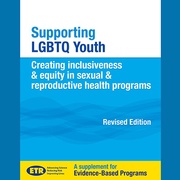ETR's Health Equity Framework in Practice: Creating an LGBTQ Inclusive Curriculum
By Marcia Quackenbush, MS, MFT, MCHES | May 8, 2018
Senior Editor, ETR
LGBTQ students have plenty of reasons to feel like they don’t “fit” in a lot of schools. They are likely to experience pervasive harassment and discrimination, which may be delivered by peers, educators or administrators. Most attend classes that make no reference to their relationships, LGBTQ contributions to society, or the history of the gay and transgender rights movements.
ETR's Health Equity Framework gives us a way to examine issues such as these and be more focused and intentional about the steps we take to address them.
Health Equity Up Front
The specific risks LGBTQ youth face in sexual and reproductive health are often neglected in sex education curricula. This is especially troubling because in some areas, these students’ risks are greater than other students (with outcomes such as earlier sexual debut, greater risks for STD and unintended pregnancy, more sexual partners, more frequent high-risk sexual behaviors and higher rates of sexual victimization).
.png) Most sexual health programs were developed well before our national conversation addressed areas of LGBTQ inclusion. Few are written from an inclusive perspective. Schools and community programs that have wanted to enhance LGBTQ inclusion are sometimes uncertain how to adapt programs in ways that respect the fidelity of the programs.
Most sexual health programs were developed well before our national conversation addressed areas of LGBTQ inclusion. Few are written from an inclusive perspective. Schools and community programs that have wanted to enhance LGBTQ inclusion are sometimes uncertain how to adapt programs in ways that respect the fidelity of the programs.
Health equity is a priority commitment for ETR. The lack of LGBTQ inclusiveness in school or community settings is a matter of great concern. Many of these issues can be addressed forthrightly by our Health Equity Framework (HEF) (see box). The four factors in the HEF are reflected in some of our recent work addressing LGBTQ inclusivity.
ETR’s Health Equity Framework
The Health Equity Framework is a tool that helps us be more intentional and grounded about issues of health equity in all of our projects. It highlights four interconnected factors that influence health and advance, or impede, health equity. These factors are (1) systems of power; (2) relationships and networks; (3) individual factors; and (4) physiological pathways.
When health equity is present, individuals and communities have the personal agency and fair access they need to utilize resources and opportunities. These, in turn, bring about the best possible health outcomes in physical, emotional and social realms.
When health disparities exist, they reflect preventable differences in health outcomes related to social, economic and environmental conditions.
Developing an Inclusive Supplement
ETR partnered with the New York City Department of Health and Mental Hygiene, and one of their projects, the Bronx Teens Connection, to develop, test and disseminate an LGBTQ-inclusivity supplement for sexual and reproductive health programs. This supplement helps combat disparities experienced by LGBTQ youth and allows educators to bring a stronger and more effective frame to the implementation of sexual health programs.

Use of the supplement allows communities, schools and educators to build and support strengths among sexual minority youth. These include confidence in their identity, positive self-esteem, and a stronger sense of connectedness and belonging in school and community.
The supplement includes background for educators, a 1-2 session class for students that is delivered before a program, a discussion guide that educators can use to enhance inclusivity within any sex education program, and a resource guide for students. The materials were reviewed by community-based subject experts and LGBTQ youth advisors. The supplement is designed to work as an acceptable (“Green Light”) adaptation to evidence-based programs.
Initial analyses of the curriculum showed that teachers found the material easy to use, students were engaged, and the supplement had positive impacts for all students on LGBTQ knowledge as well as overall understanding of sexual and reproductive health.
Examples from the Health Equity Framework
ETR’s Health Equity Framework provides an opportunity to think about a range of programming approaches that are relevant to LGBTQ youth in sexual and reproductive health education. The examples below highlight some of the factors within the Framework that are engaged by our inclusivity supplement.
Example: Relationships and Networks
- Strengthens teachers’ ability to teach students’ skills to accept and contribute to a safe and supportive classroom environment that is inclusive of LGBTQ youth.
- Strengthens teacher relationships with LGBTQ-identified students by recognizing and affirming their identities and authentic selves within the classroom.
- Identifies effective resources for LGBTQ youth (e.g., national voluntary organizations).

Example: Biological Pathways
-
Helps diminish stress and trauma that result from discrimination, lack of connectedness and victimization. These factors can affect physical, mental and psychological processes, including health outcomes and learning and academic performance.
Example: Individual Factors
- Builds LGBTQ students’ self-esteem and confidence to make health promoting choices by affirming positive attitudes about LGBTQ individuals and addressing issues with relevance to LGBTQ youth.
- Builds student competence by including skills-practice relevant to LGBTQ relationships (e.g., inclusive role-plays and stories, emphasis in discussion on “Who needs to know this information?”). Replacing the strong heteronormative emphasis in sexual and reproductive health curricula with an inclusive perspective enhances the relevance of learning for all students.
- Encourages LGBTQ youth to recognize their own vulnerabilities, then build intentions and skills to choose healthy behaviors, by addressing health behaviors in an inclusive manner.
- Increases effectiveness of risk reduction lessons by correcting misperceptions about the prevalence of risk for LGBTQ students—a misperception that can exist among students, educators and administrators alike.
A Tool for Better Focus
We are proud of the LGBTQ Supplement and the ways it addresses health equity. We are excited about the potential of the Health Equity Framework. It allows us to be more specific in our focus, more thorough in our intentions, broader in our approaches, and more comprehensive in our thinking.
We hope this framework will be a useful tool for other organizations committed to health equity in human services, health education and research.
Marcia Quackenbush, MS, MFT, MCHES, is Senior Editor at ETR and manages ETR’s blog and newsletters. She can be reached at marcia.quackenbush@etr.org.





